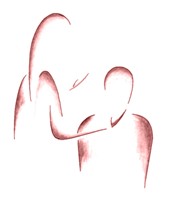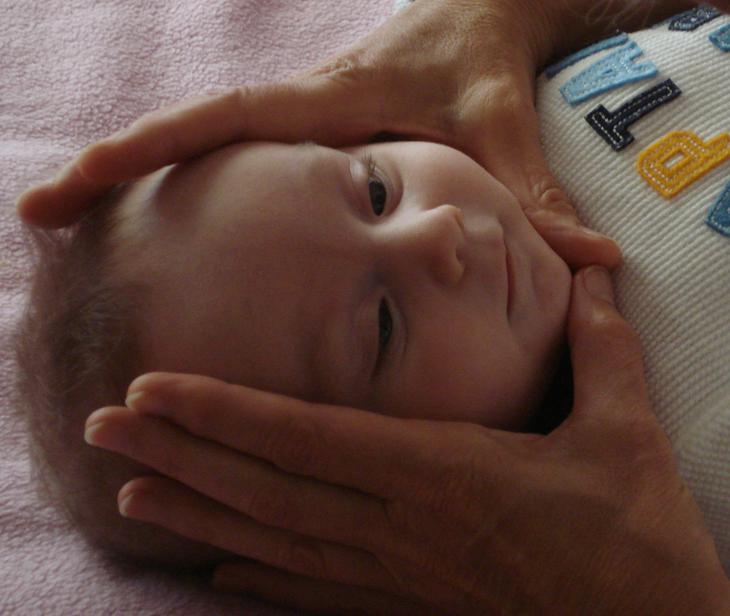Pediatrics
Why does she cry so much?
Why is nursing such a struggle?
Why is his body so stiff all the time?
What am I doing wrong? I am exhausted!
Just a few of the many questions asked by new moms.
THERE IS HELP both for you and your baby!
Top left image:
This little one, only two weeks old, is registering loudly what she thinks of the tightness in her body.
Bottom left image : she is totally relaxed after her dural tube release. Gone is the stiff wee body, she is now a lovely, soft and relaxed newborn.
Top right image: Newborn experiencing cranial release.
Bottom right image: The relationship between me and my four month old baby "client" is obvious - she loved her treatments!
Listening Hands Physiotherapy
Physiotherapy Delivered With a Difference
Birth Traumas which respond to CST
- click on above box to see video of treatment of 11 day old baby. (Quicktime is required to view video so you may have to download the program in order to view the actual video, site is under construction to eliminate this step.)
- Delivery by forceps or vacuum suction
- Transverse positioning of the unborn infant during labour
- Breech or other abnormal delivery positions
- Cesarean Section - there is a sudden change of pressure, the head does not go through the molding to pass through the birth canal. Often the force exerted by the physician to remove the infant itself can cause trauma . Normally hormones facilitating the birth process are released and baby is aware change is about to happen. In C Section, there is no signal, just dark quiet safe, to bright lights, hands, chaos. This is very hard on baby.
- Umbilical cord around the infant’s neck
- Drugs used during labour
- Long, hard labour during which the infant’s head is pushed against the mother’s pelvis, thus excessively compressing the cranium.
Pictures to top left show unwinding and soft posture achieved as a result.
Symptoms of Distressed CranioSacral System in New Born
- Holds body in excessive extension (arched), "lifting" head up, often described as having a “strong neck” when in fact, it is the result of a tight dural tube
- Resists sitting in cuddle seats or being held in flexed position
- Difficulty nursing, (poor suck reflex, poor rooting reflex, inadequate mouth opening, retracted or protracted jaw, poor latching, difficult to feed on one side).
- Slumps and holds head to one side
- Dislikes lying on either stomach or back
- Unable to turn head from side to side when on stomach
- Colic
- Projectile vomiting
- Poor sleeping patterns
- Hair pulling, or hitting head classic abnormal cranial tension
Prenatal Wounding
Just as physical problems in the womb can create problems later, emotional stress sensed by the unborn child can also influence its health and well-being following birth. A simple example is when a death occurs in the family during the pregnancy, creating grief for the mother and other family members.
When a newborn displays symptoms previously described of a distressed CSS, they may be the result of an emotional prenatal experience. Gentle CST techniques can often alleviate these internal CSS problems.
If you think this may apply, it can be discussed in detail at your first appointment.
Length & Duration of Treatment Sessions
Ideally, treatment should begin before abnormal restrictions and patterns become accepted by the body as “normal” after which they may be more time consuming to reverse.
The initial treatment is one hour with subsequent visits for the newborn or young infant normally being 45 minutes, unless additional time is needed for discussion with parents. For simple problems, one or two treatments are sufficient, but in the case of difficult problems, additional treatments may be needed to get lasting results.
Symptoms of A Distressed CSS in Infants over 3 Months
- Unable to lift head and look easily side to side when on stomach, unable to prop on forearms while on stomach
- Neglects one side (only one hand goes in the mouth, more movement on one side than the other)
- Continues to be irritable, with restless sleep
- Pulls or rubs ears or hair
- Uses rocking motions (may hit or bang head) which may indicate serious abnormal pressure in the cranium
- May be floppy, labile child uninterested in moving. May also show other signs of being developmentally delayed
Other Conditions . . .
Spinabifida, cerebral palsy, ADHD, intracranial hemorrhage, visual difficulties, torticollis, oxygen deprivation, fetal alcohol infants and premature infants. Epilepsy, whether it is present from birth or appears at a later age, should be treated immediately with CST.
Further Readings
Applications of CranioSacral Therapy in Newborns and Infants, Part I
http://www.massagetoday.com/archives/2003/05/08.htmlApplications
CranioSacral Therapy in Newborns and Infants, Part II
http://www.massagetoday.com/archives/2003/06/13.html
Physio is lots of fun!!
Hanging out, sound asleep, after treatment.

